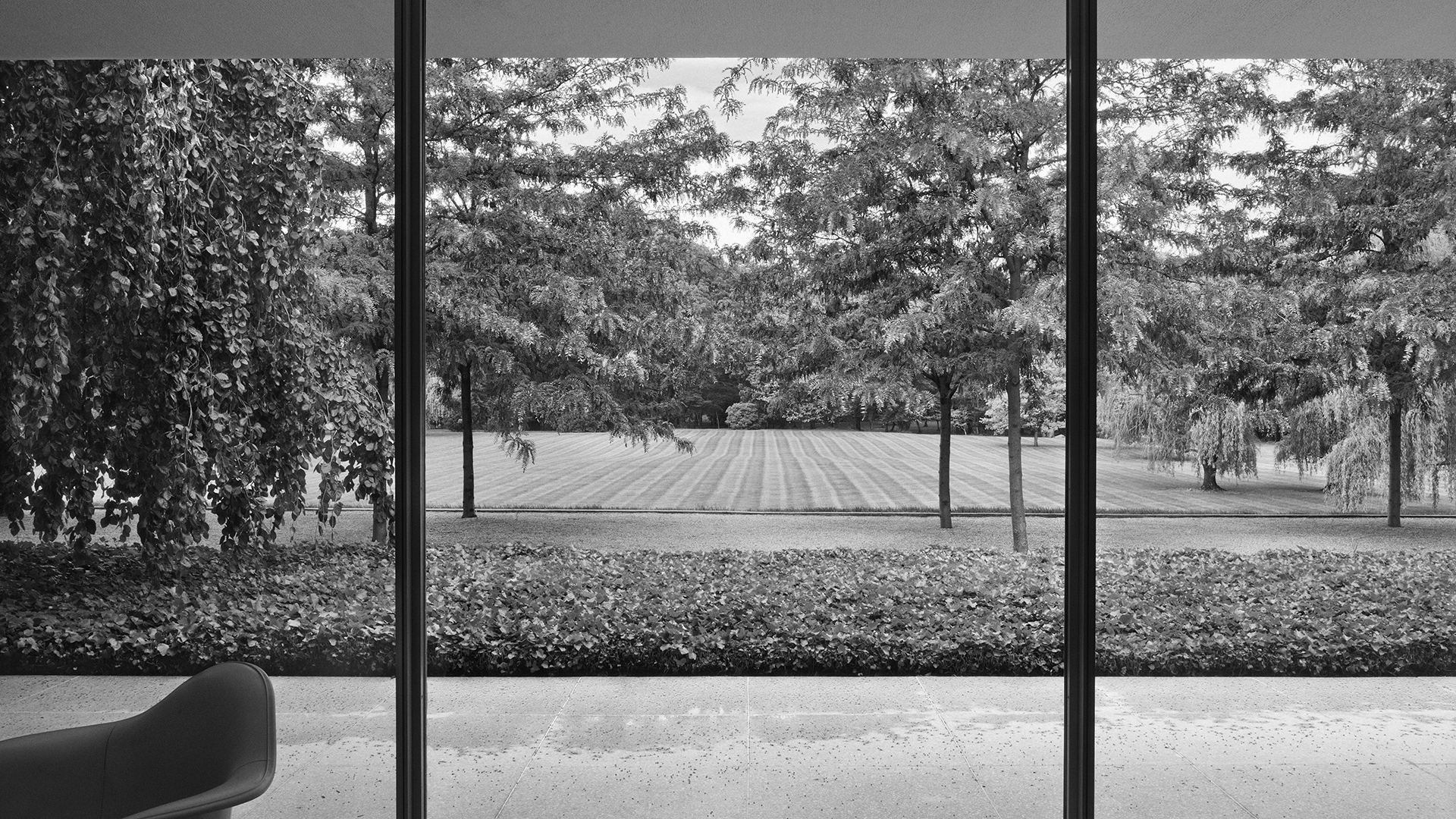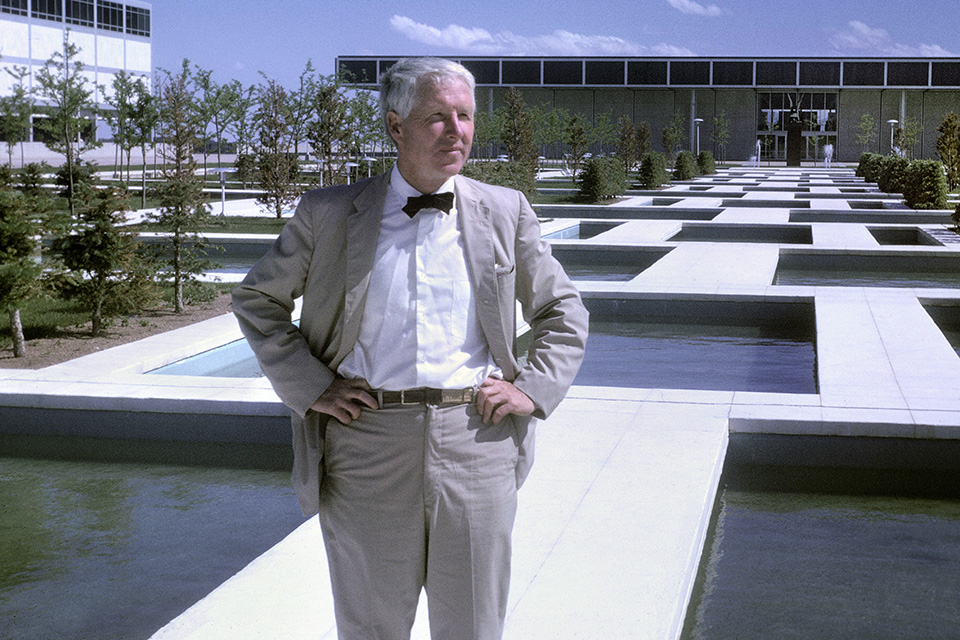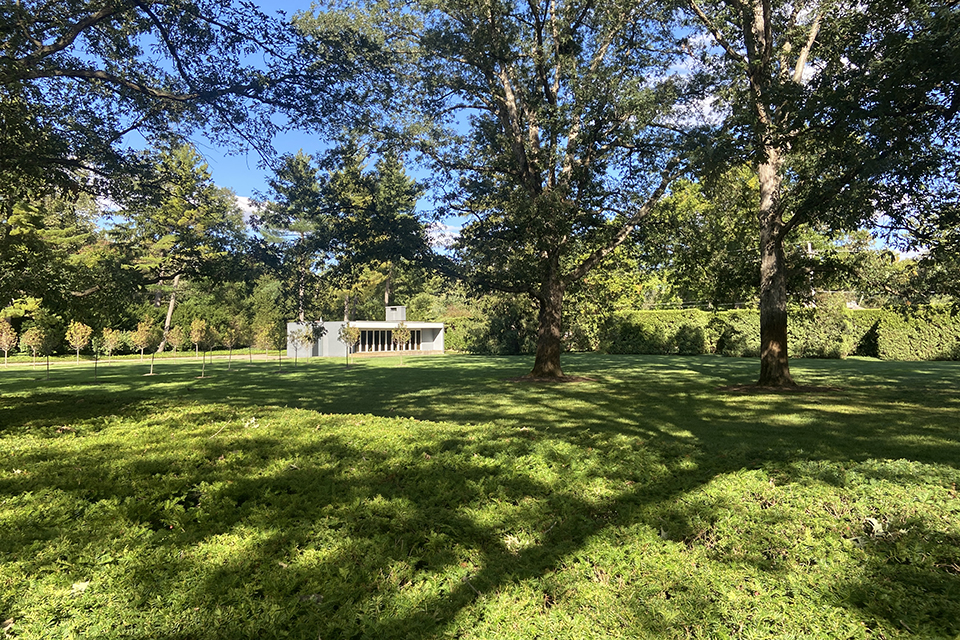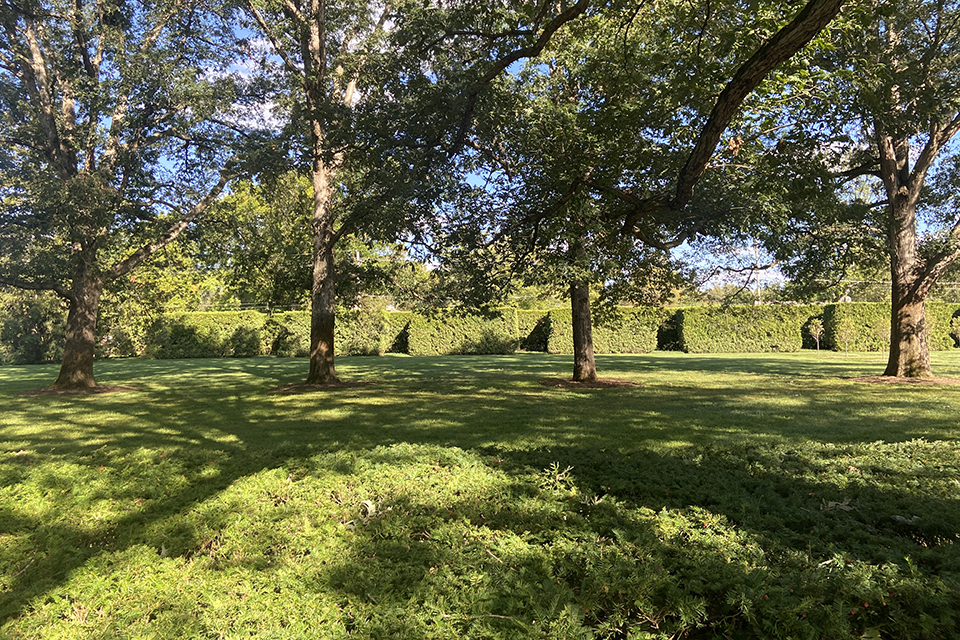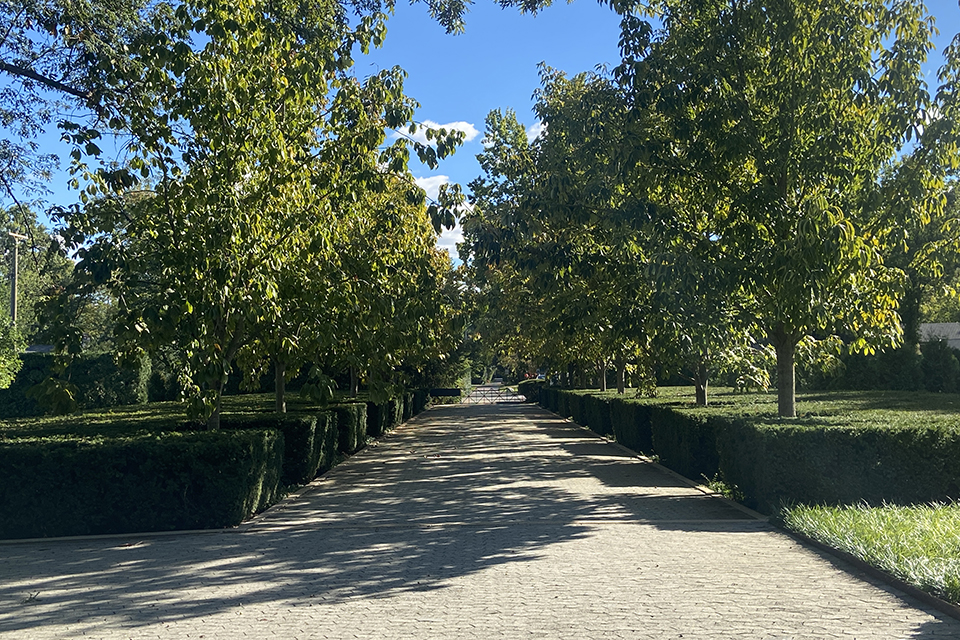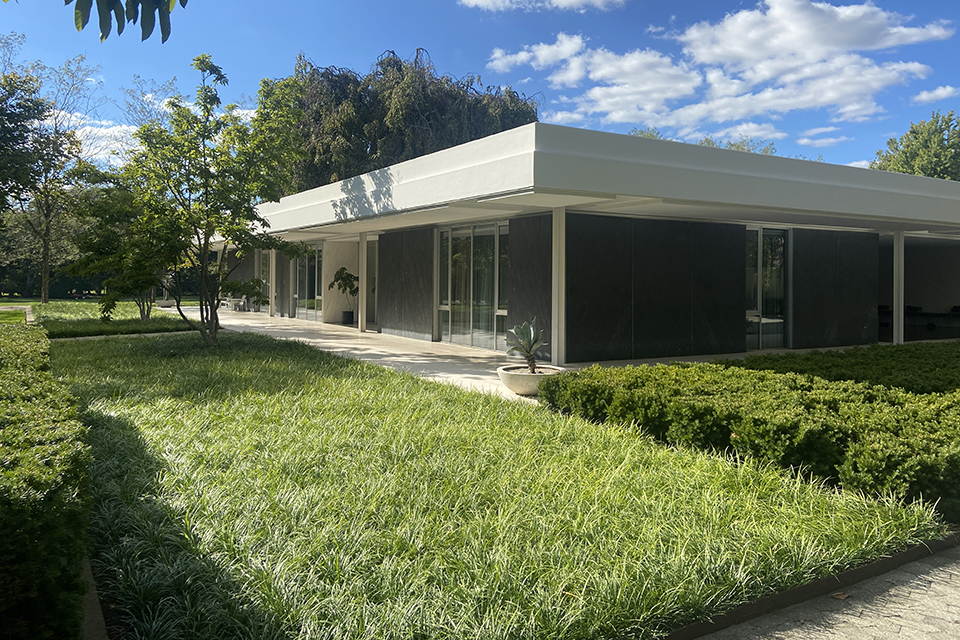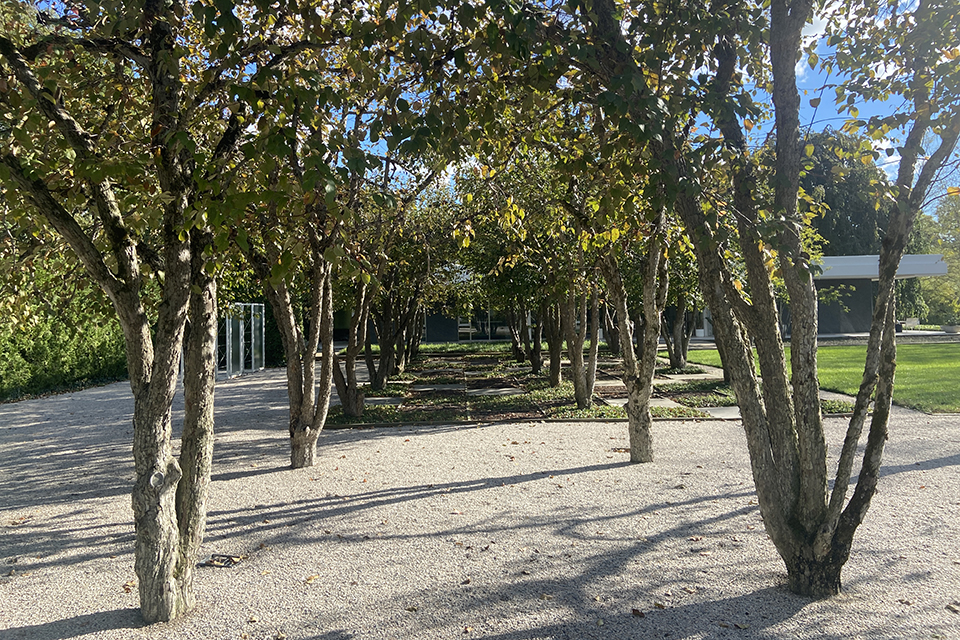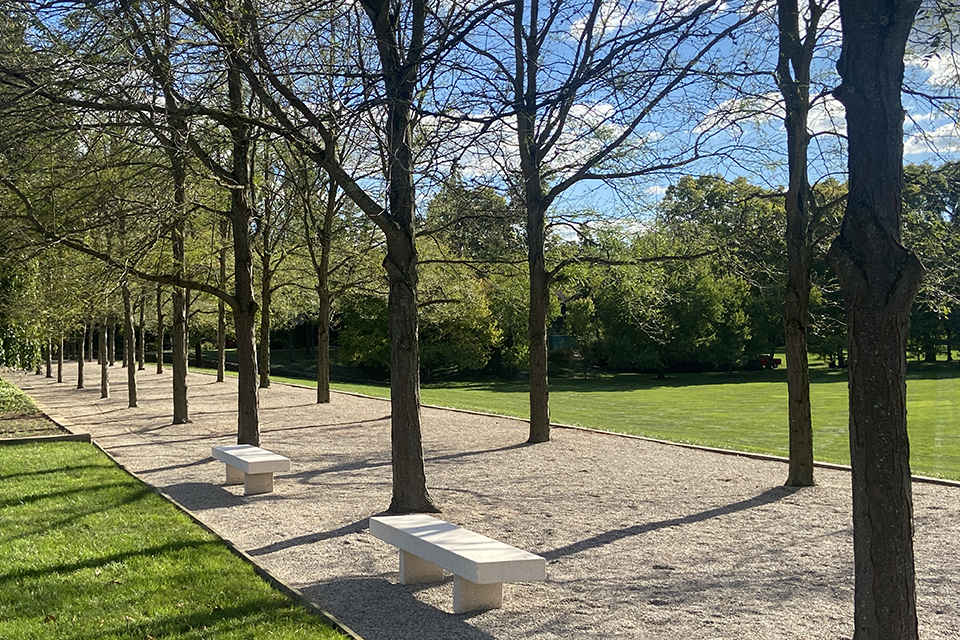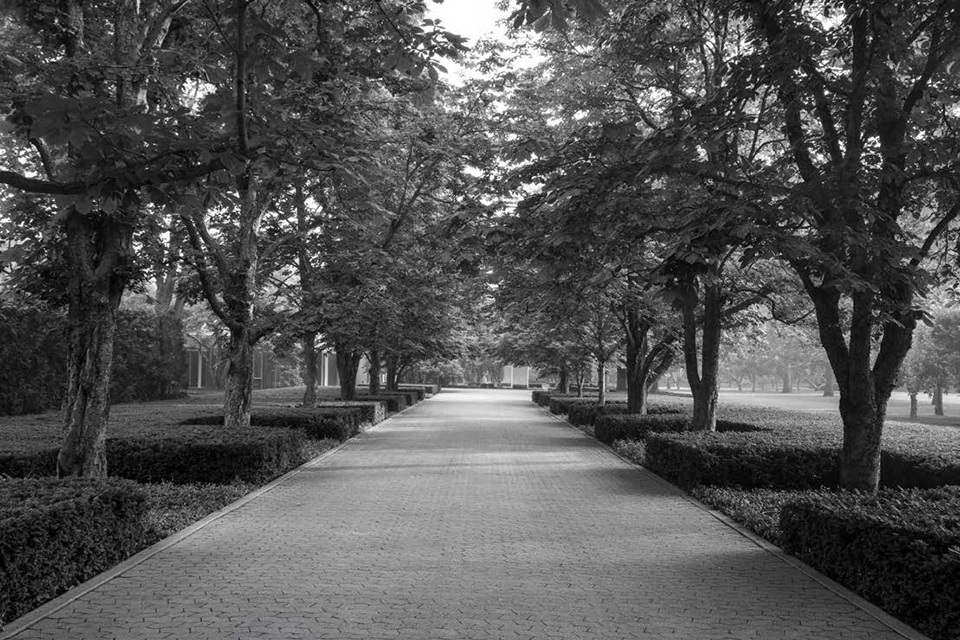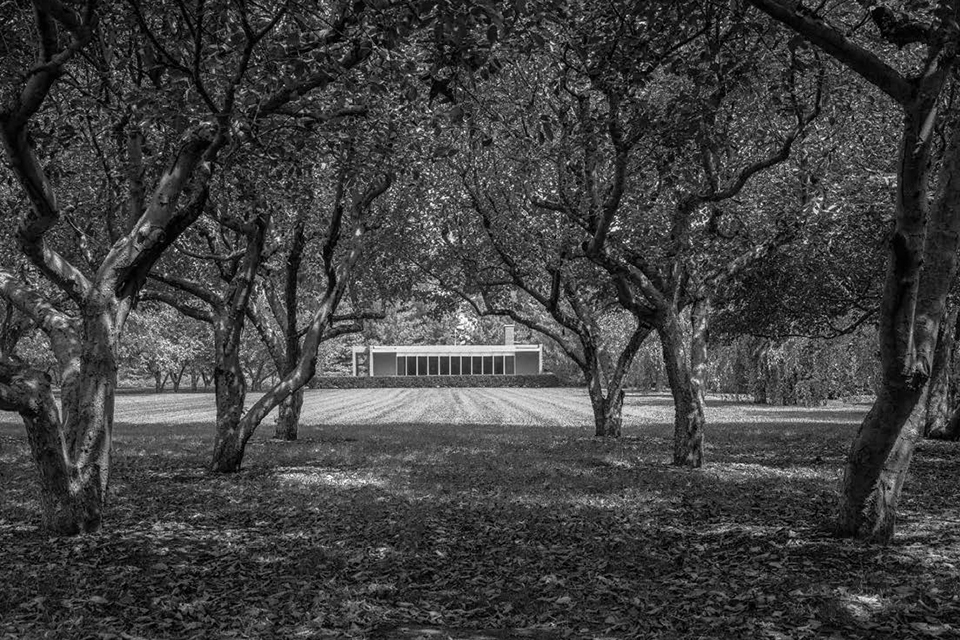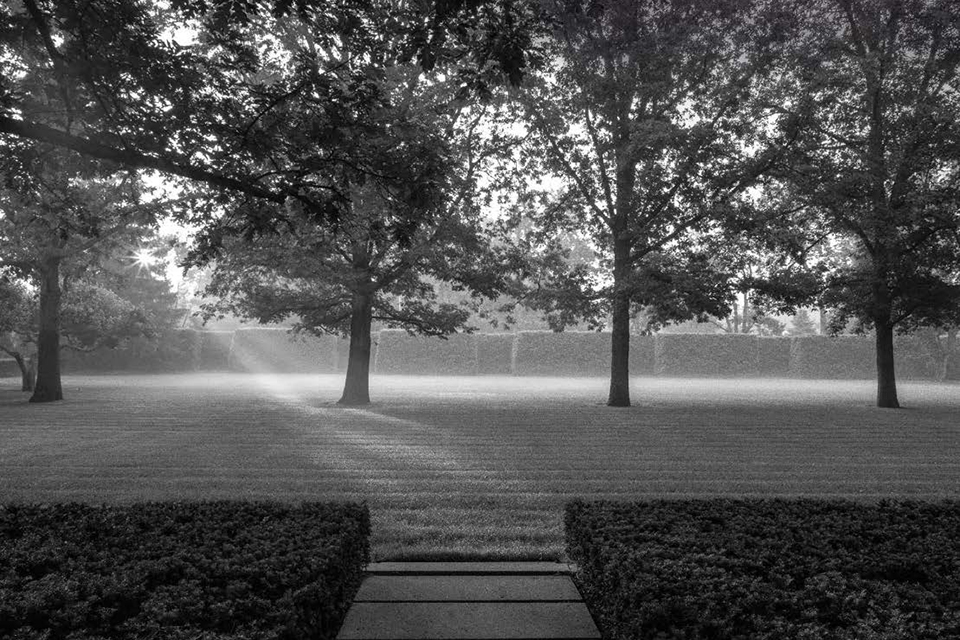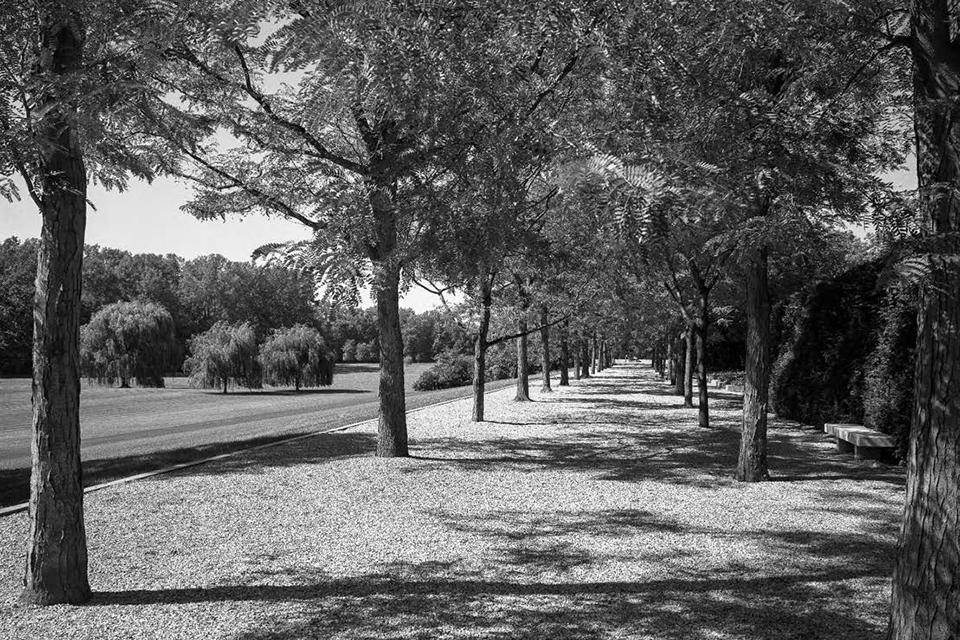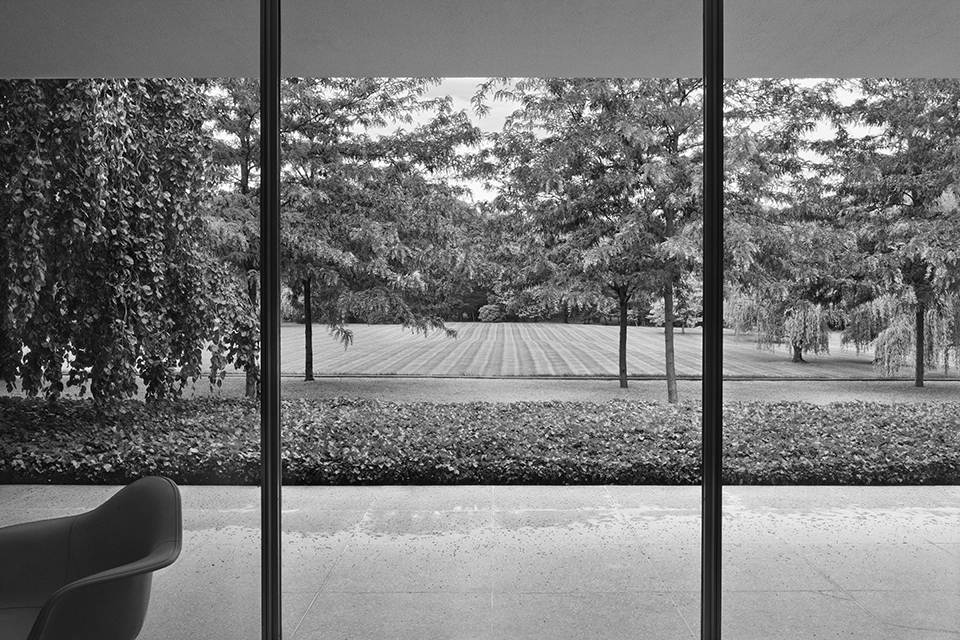Considered to be his residential masterpiece and an iconic Modernist garden, this thirteen-acre property was developed by the Office of Dan Kiley between 1953 and 1957 as a unified design through the close teamwork of Dan Kiley, architects Eero Saarinen and Kevin Roche, interior designer Alexander Girard, and clients Irwin and Xenia Miller. The house interior is arranged around a cruciform grid of steel columns. Kiley worked with the architects to create a seamless connection between the interior and the landscape, setting the home atop a 25-foot-wide platform on which sits a ten-foot-wide terrazzo terrace. The terrace acts as a physical bridge between the interior of Saarinen’s rectilinear structure and the garden. Two weeping beeches are planted at the edge of the patio to the west of the house, adding height and movement to the space.
Background
Kiley’s plan for the garden, divided into multiple outdoor rooms, or “pinwheeling spaces,” spins outward from as it responds to the orthogonal, geometric order of the house, without being constrained by a strictly symmetrical layout. According to landscape architect Peter Schaudt, “What makes it so modern is that Dan took lines that emanated from the house”; his work “grows from the architecture.” Kiley’s former colleague Peter Walker has said: ‘’For many of us, [Miller Garden] was where modernism began.”
The entrance drive is flanked by an allée of horse chestnut trees, with a gridded orchard of apple trees planted just east of the drive. The landscape’s most prominent and photographed feature is an allée of honey locusts (a signature element of André Le Nôtre’s Versailles) that define an axis along the west side of the house and extends almost to the limits of the property. Breaking with tradition, the view from the residence looks through rather than down the line of trees. Gary Hilderbrand, Chair of the Department of Landscape Architecture at Harvard University’s Graduate School of Design has said, “I don’t know where else I’ve seen that. [Kiley] took the conventions of landscape and twisted them just so.” Historically, sculptures by Henry Moore and Jacques Lipschitz anchored the two ends of the axis. Finely textured, buff-colored crushed stone contrasts with the dark green of the honey locust leaves. Edged by a row of red maples, an open, managed meadow slopes toward the river, ultimately becoming a natural wooded area.
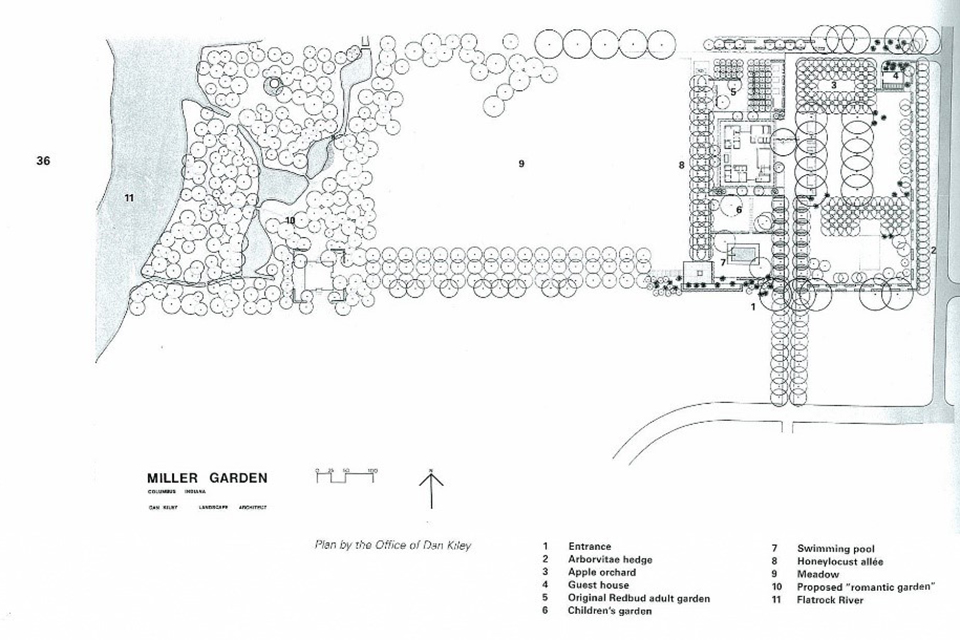 Plan of Miller Garden, Columbus, IN. Image by Office of Dan Kiley, courtesy the Cultural Landscape Foundation.
Plan of Miller Garden, Columbus, IN. Image by Office of Dan Kiley, courtesy the Cultural Landscape Foundation.
In 1975 Peter Walker, with a grant from the National Endowment for the Arts, commissioned celebrated landscape photographer Alan Ward to photograph the garden, and produced an exhibition that was hung in the lobby of Harvard’s Gund Hall. In 1999 landscape architect John Curtis renewed the garden’s plant materials, replacing the failed redbud grove with crab apple trees and restoring the honey locust allée. The Miller property became a National Historic Landmark as part of a larger theme study for Modernism in Columbus, Indiana, in 2000.
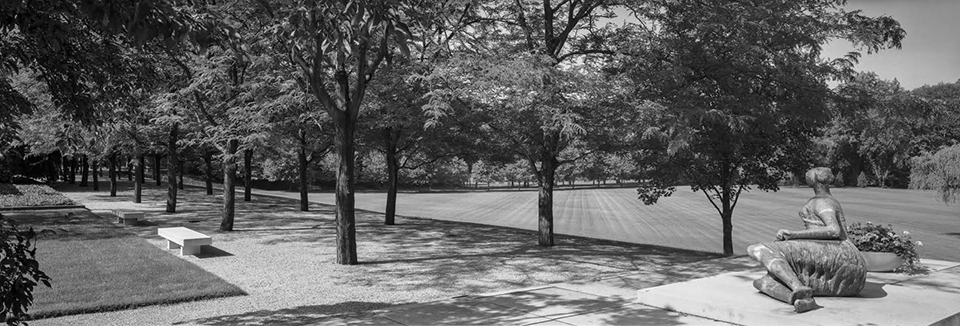 Panorama of south end of Honeylocust allée at the Miller Garden, Columbus, IN, 1996. Photo by Alan Ward.
Panorama of south end of Honeylocust allée at the Miller Garden, Columbus, IN, 1996. Photo by Alan Ward.
J. Irwin Miller died in 2004; the property was the home of Mrs. Miller until her death in 2008. The Miller heirs, while not wishing to retain ownership, were nevertheless keenly interested in securing the property’s long-term preservation and its availability to the public for educational purposes.
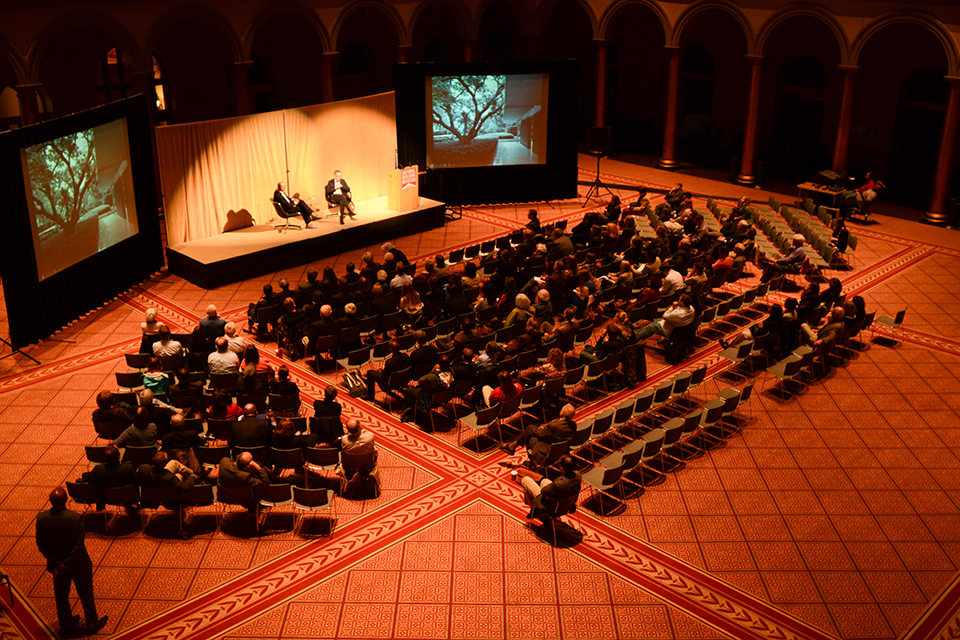
Charles A. Birnbaum and Gary Hilderbrand discuss the Miller Garden at Spotlight on Design: Reed Hilderbrand and the Lecacy of Dan Kiley, National Building Museum, Washington, D.C., 2014. Photo courtesy The Cultural Landscape Foundation.
Advocacy and Engagement
Miller Garden was at a watershed moment in its history. TCLF enrolled it (along with Heritage Park Plaza, Lake Elizabeth, Manhattan Square Park, Mill Creek Canyon Earthworks, and Peavey Plaza, also included in this year’s report) in its 2008 Landslide report, titled Marvels of Modernism. The program’s partners included the George Eastman Center of International Photography and Film, in Rochester, NY, and Garden Design, which, along with TCLF, co-curated a traveling exhibition of newly commissioned photographs of at-risk landscapes. Design Within Reach showrooms and regional American Society of Landscape Architects chapters (including New York, Chicago, Northern California, Illinois, and others) co-hosted traveling signboard exhibits that were displayed in more than a dozen cities. The travelling exhibition garnered public and media attention, including from The New York Times.
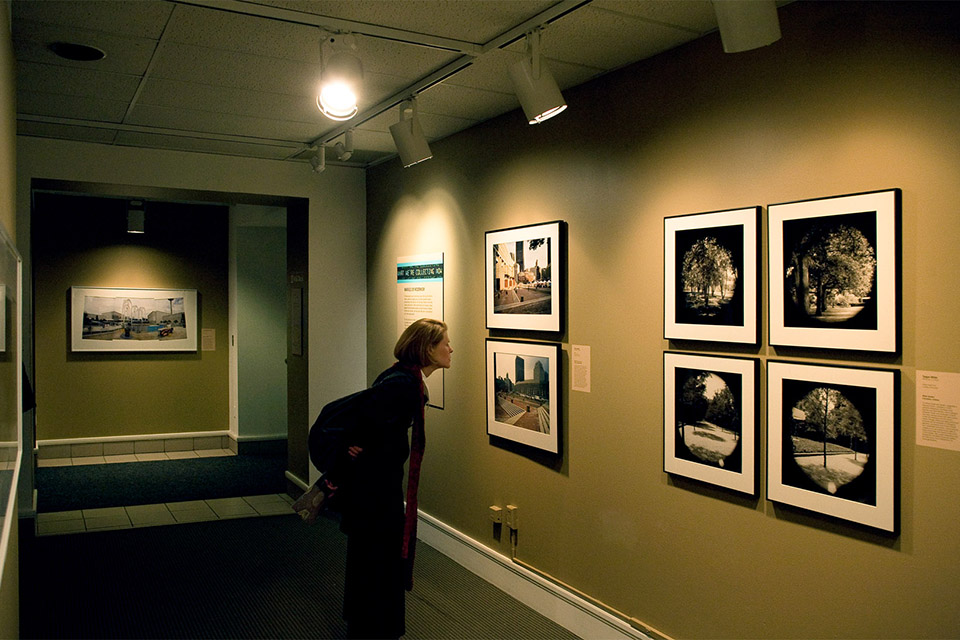 Marvels of Modernism Exhibition, George Eastman Center of International Photography and Film, Rochester, N.Y., 2008. Photo courtesy of The Cultural Landscape Foundation.
Marvels of Modernism Exhibition, George Eastman Center of International Photography and Film, Rochester, N.Y., 2008. Photo courtesy of The Cultural Landscape Foundation.
TCLF warned that if Miller Garden was to make a transition from private home to public site, its care must be transferred to an organization capable of meeting its many challenges. Adequate stewardship for the property would require physical maintenance of the house, its associated collections, ancillary buildings, and landscape, as well as capability for interpretation and public programming. Failure to affect such a transition would place the property in jeopardy of being offered on the open market, leaving its preservation and future public access in question. TCLF supported the Indianapolis Museum of Art’s bid for the property, and in 2009 the Miller family donated the Miller Garden to the museum. The property was opened to the public in 2011.
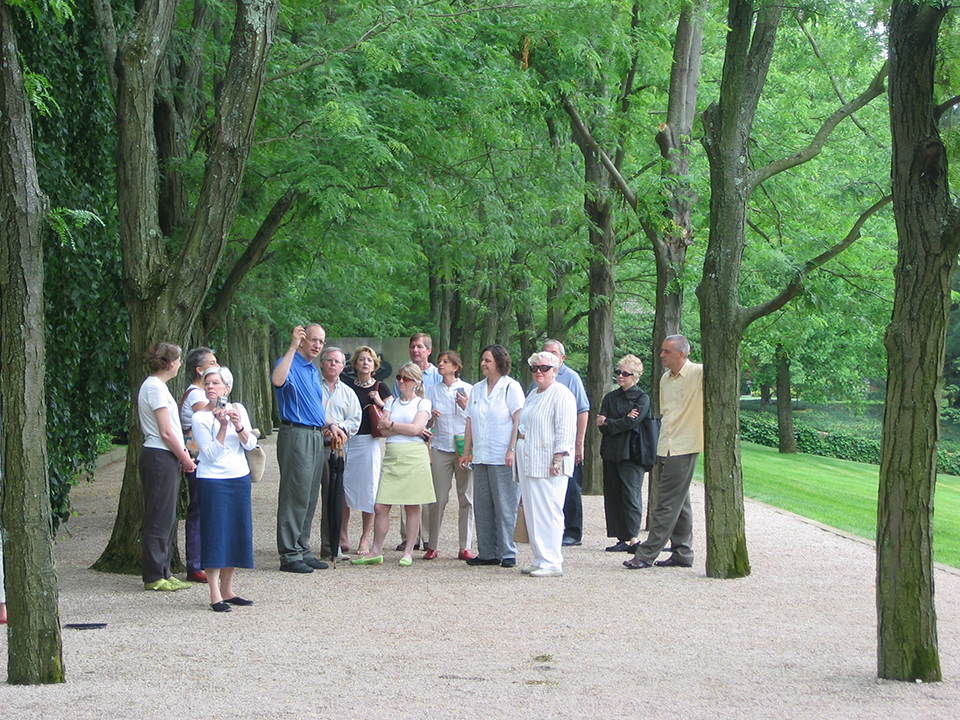 TCLF board members at Miller Garden, Columbus, IN, 2005. Photo by Charles A, Birnbaum, courtesy The Cultural Landscape Foundation.
TCLF board members at Miller Garden, Columbus, IN, 2005. Photo by Charles A, Birnbaum, courtesy The Cultural Landscape Foundation.
When the centennial of Kiley’s birth in 2012 went uncelebrated, TCLF dedicated its 2013 annual Landslide report to the life and work of this design icon, honoring his legacy and calling attention to the need for informed and effective stewardship of his work – and by extension, Modernist landscape architecture. TCLF embarked on creating a traveling photographic exhibition: The Landscape Architecture Legacy of Dan Kiley, which included 45 newly commissioned photographs of Kiley’s designs, and opened at the Boston Architectural College on November 14, 2013, touring nationally since that time.
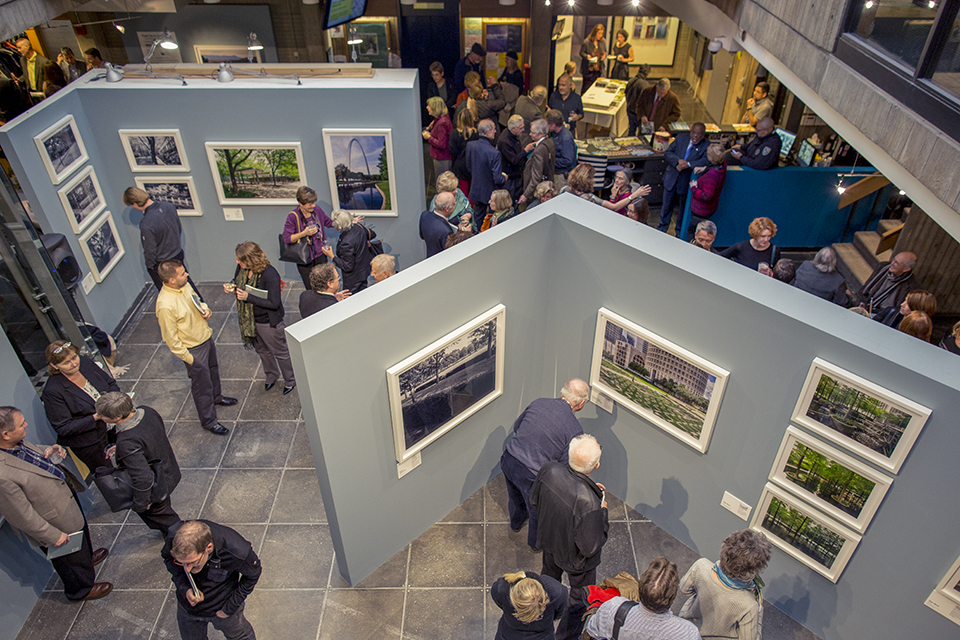 The Landscape Architecure Lecacy of Dan Kiley exhibition, Boston, MA, 2013. Photo © Sam Rosenholz, courtesy Boston Architecual College.
The Landscape Architecure Lecacy of Dan Kiley exhibition, Boston, MA, 2013. Photo © Sam Rosenholz, courtesy Boston Architecual College.
Artists donated their time and work (including Millicent Harvey’s photographs of the Miller Garden), along with professional associations, landscape architecture firms, and individuals who underwrote the exhibition. A full-color gallery guide was funded through a Kickstarter campaign. The exhibition website included information on 28 Kiley sites, a biography of Kiley, resources, and recollections by landscape architects including (amongst others) Cheryl Barton, Cornelia Hahn Oberlander, Jack Smith, Kevin Roche, Peter Ker Walker, and Harry Wolf.
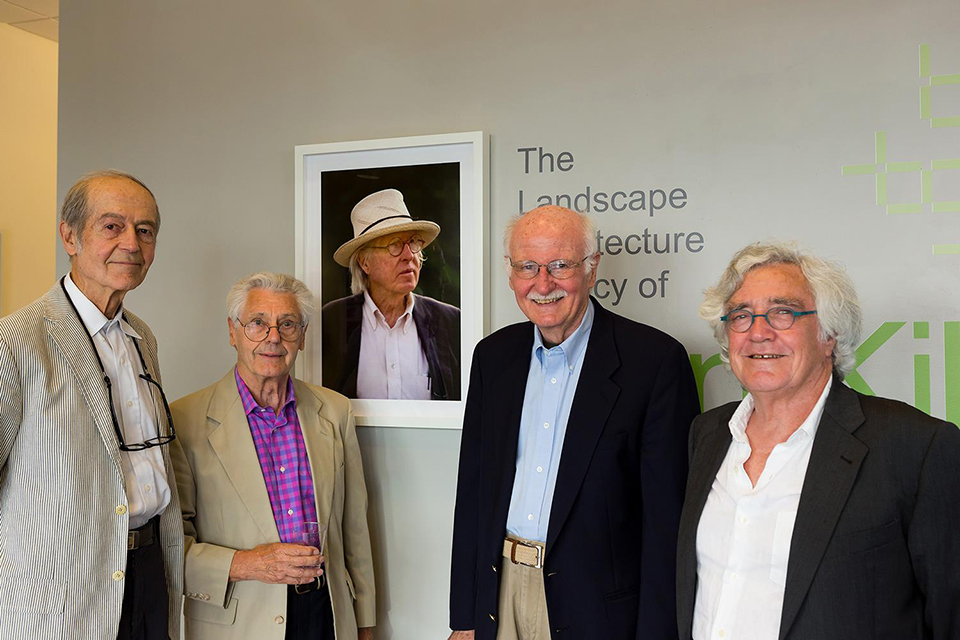 The Landscape Architecure Lecacy of Dan Kiley exhibition attendees (left to right) Henry Arnold, Peter Ker Walker, Joe Karr, and Ian Tyndall, Columbus, IN., 2014. Photo courtesy Tony Vasquez.
The Landscape Architecure Lecacy of Dan Kiley exhibition attendees (left to right) Henry Arnold, Peter Ker Walker, Joe Karr, and Ian Tyndall, Columbus, IN., 2014. Photo courtesy Tony Vasquez.
TCLF noted then that the present-day condition of Kiley’s legacy is mixed, which is as true in 2023 as it was in 2013. Some works are being neglected while others are doing well. The Indianapolis Museum of Art at Newfields has been an excellent steward of Miller Garden, setting a high standard for the curatorial management of Modernist landscape architecture. David Rubin Land Collective is currently working with project lead, Penn Praxis, along with Newfields/Indianapolis Museum of Art to develop a conservation management plan for the house and landscape. The work is made possible by a $170,000 grant from the Getty Foundation as part of its “Keeping It Modern” initiative. The Miller House and Garden is one of only two projects awarded funding in the United States, an indication of the significance of the site. As Randy Mason, senior fellow with PennPraxis noted, “interpreting the subtle changes made to the site can enrich the story of the extraordinary design and the challenges of curating whole buildings and landscapes.” Clearly, Kiley’s great influence continues undiminished.
Selected Resources
“Dan Kiley – Almost Famous,” February 11, 2013
“Dan Kiley Past and Present,” June 1, 2003
“Dimensions of Dan Kiley,” Chris Dunn, September 16, 2019
“Feeling a Dan Kiley Landscape”
Harriet Pattison Biography: Working in Dan Kiley’s Office
“The Big Pre-Oscar Snub,” August 21, 2017
The Office of Dan Kiley: Joe Karr Biography; Wings Point
What’s Out There The Landscape Architecture Legacy of Dan Kiley, Gallery Guide
“Workshop Introduces Students to the Landscape Architecture of Dan Kiley”
Selected Media Coverage
“A Campaign for Kiley,” Timothy A. Schuler, Landscape Architecture Magazine, September 30, 2021 “Dan Kiley – The Great Designer Behind Fountain Place – Featured in Touring Exhibition,” Jerome Weeks, Art and Seek, November 21, 2013 “Dan Kiley’s Landscapes,” Mark Jenkins, The Washington Post, April 12, 2014 “The Landscape Architecture Legacy of Dan Kiley’ Review: Urban Oases,” Julie V. Iovine, The Wall Street Journal, April 22, 2015 “Modernism Week Remembers the Legacy of Modernist Landscape Architect Dan Kiley,” Katherine Guimapang, Archinect News, February 19, 2019 “See 10 Groundbreaking Projects by Landscape Architect Dan Kiley,” Tim McKeough, Architectural Digest, February 28, 2015 “TCLF’s First Instagram Curator: Millicent Harvey”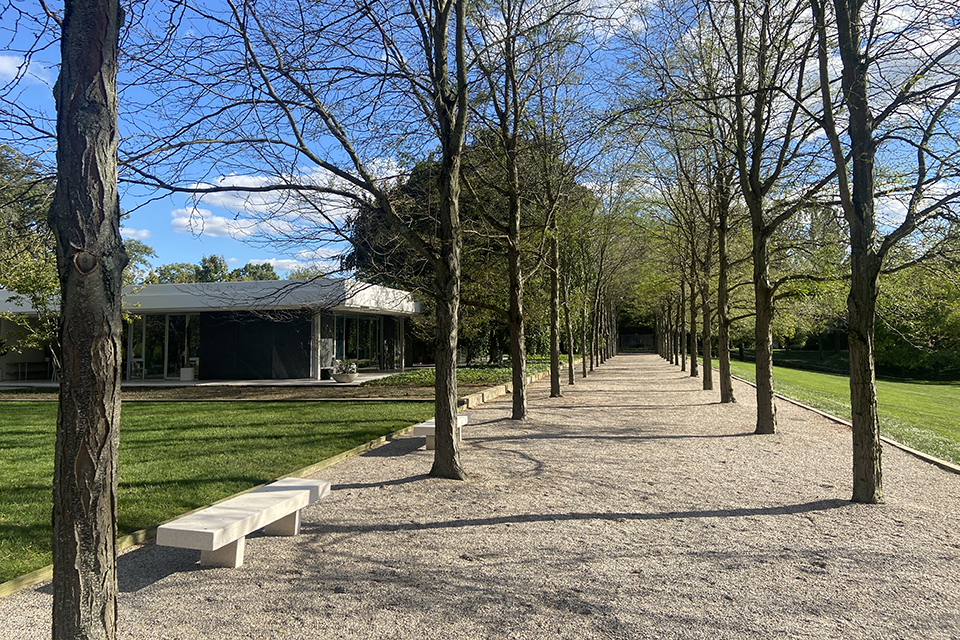
-
Miller Garden, Columbus, OH, 2022. Photo by Charles A. Birnbaum.
